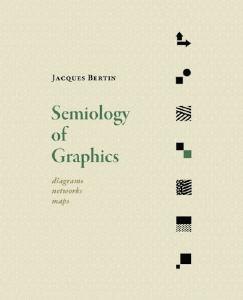Bertin's Books (Semiology of Graphics)
Jacques Bertin was a French cartographer who had lots of ideas about visualization, before there was a field of visualization. Many of the ideas we use in visualization today can be seen in his work, although reading these “original sources” can be challenging.
Bertin’s books, while historically interesting, are not really suitable for class. They are hard to read. A part of the problem is that they are translated from French (and it shows). Part of it is that he was thinking in very formal ways, trying to define things very particularly. Another problem is that things are so old that they lack context: he was doing things by hand, and had little way to use color.
Most of his key ideas have been re-discovered by others since he wrote them. So, we’ll see lots of references to Bertin throughout the class, but you won’t be required to read the original sources.
But, if you’re really interested in visualization, the books are amazing. So many ideas that would be re-discovered are described in interesting ways. It’s amazing to see how he invented interaction concepts without a computer!
Semiology of Graphics

Bertin’s most famous book is Semiology of Graphics. It was published in 1967 as Semiologie graphique: les diagrammes, les réseaux, les cartes. There was a 1980s translation (published by the University of Wisconsin Press!), but it is out of print and hard to find. There is a 2010 translation that is printed in a really nice new edition by ESRI press (map makers). It’s a well-produced book, the images are wonderful. The new translation is much better, but it still is hard to read (both because French doesn’t translate well, and becuase the ideas are dense).
You can buy a copy on Amazon or see the publisher’s page. Of course, you can get it from the library in the original French.
Graphics and Graphic Information Processing
This is a less famous book by Bertin. It’s from 1977 (so he is aware of the possibility of “automation”), and there is a 1981 translation to English. The cool thing is the library has online access so you can read it online!
I have not read most of it, but it starts with an interesting example. I will provide this introduction as an optional reading.